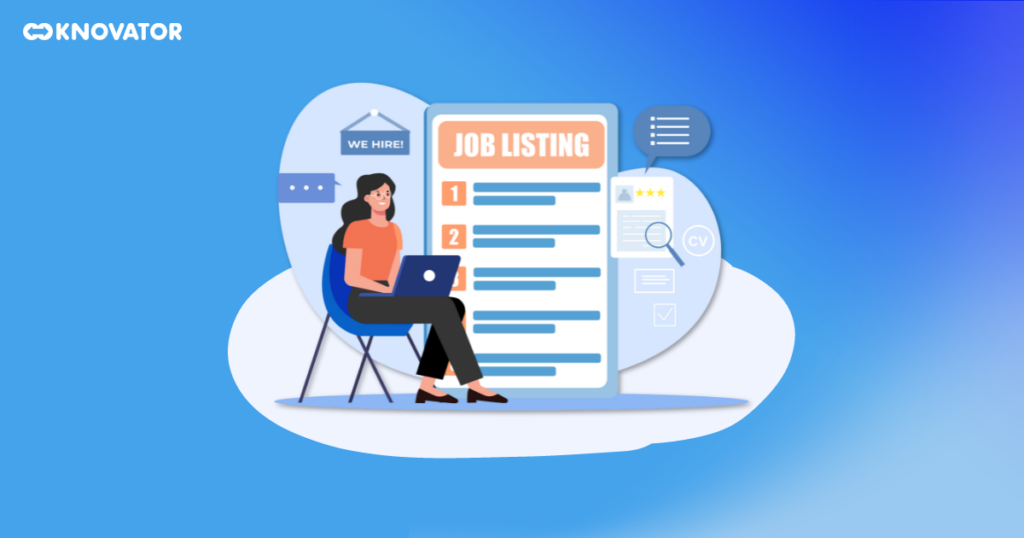The job board industry is a thriving marketplace that connects employers with potential candidates.
But how exactly do these platforms make money? We will delve into job boards’ various profit-saving methods, from charging employers for listings to offering premium services.
By the end of this blog post, which will explore five job board business models job boards can leverage to generate revenue, you will have a strong understanding of the financial mechanics that power the job board industry.
Also Read: LinkedIn’s $10 Billion Milestone: Bridging the Gap Between Companies, Talent, and Customers
How Do Job Boards Work?

1. Employers Post Jobs
Companies advertise their open positions on the job board. This typically involves creating a detailed listing outlining the job responsibilities, required skills and experience, and other relevant information. Job boards may offer free basic postings or have tiered pricing structures with additional features for premium listings.
2. Job Seekers Find Opportunities
Job seekers browse the job board’s listings for positions that align with their skills. Many job boards allow users to filter searches by industry, location, job title, and other criteria.
3. Applications Submitted
Once a job seeker finds a suitable opportunity, they can submit their application straight through the job board or be redirected to the employer’s website to complete the process.
4. Matching & Hiring
Job boards can help the initial screening process by allowing employers to filter applications based on set criteria. Ultimately, the hiring decision lies with the employer, who typically contacts shortlisted candidates for interviews.
Also Read: How Can a Recruitment Profit Calculator Help You Calculate Net Profits
Job Board Business Models
The job board industry thrives on connecting employers with the right talent. But how do these platforms make money? This blog post explores five effective business models that job boards can leverage to generate revenue and achieve long-term success.
1. Charging for job listings

Also Read: Cash Flow Challenges: Why Recruitment Agencies Struggle with Revenue Delays
2. Monetizing premium features

Imagine an employer wanting to stand out from the crowd. They can pay to have their job listing featured prominently on the search results page or displayed in high-traffic website areas. This increases the visibility of the listing and attracts more qualified candidates. Additionally, some job boards allow employers to target their job postings to specific demographics or skill sets. This ensures they reach the most relevant talent pool, saving time and resources.
Another valuable premium feature is Applicant Tracking System (ATS) integration. This allows employers to seamlessly manage applications within the job board platform, streamlining the recruitment process. Some job boards even provide access to a searchable database of resumes submitted by job seekers on the platform. This empowers employers to search for potential candidates who match their needs proactively.
3. Offering companies the opportunity to advertise and share sponsored Content

4. Partnerships and affiliate programs

Affiliate programs are another way to generate revenue. Imagine a job board partnering with a company offering resume writing services. When a job seeker clicks on an affiliate link and purchases a service, the job board earns a commission. This can be a win-win situation, as the job seeker gets help with their resume, and the job board earns revenue for referring them.
5. Employer Branding Services

Imagine a dedicated company profile page on a job board where a company can showcase its work culture, values, and employee benefits. This attracts top talent looking for more than just a job; they’re looking for a company that aligns with their values.
Job boards can also organize online or in-person career events where companies can connect directly with potential candidates and raise brand awareness. Additionally, some job boards offer social media marketing services to assist companies in promoting their job openings and employer brand on platforms like LinkedIn or Twitter. By offering employer branding services, job boards can become valuable partners for companies seeking to attract and retain top talent.
These five ways help job sites make money and build a lasting platform. The best way depends on who you want to reach, how big your job board is, and who else is out there. Consider factors. Use various models. Ensure job board success linking employers to job seekers.
Choose Your Revenue Model
This great blog post outlines five effective business models for job boards. The post starts with a clear explanation of how job boards work and highlights the value proposition for both employers and job seekers.
The five business models explored are all interesting and well-explained. Charging for job listings is the most common model, and the post offers insightful details on how variations in pricing can be used. Monetizing premium features is another great strategy, and the post gives good examples of features that employers might find valuable.
Offering advertising and sponsored content is also interesting, and the post emphasizes the importance of keeping the advertising relevant to the job seeker audience. Partnerships and affiliate programs are creative ways to expand reach and generate revenue. The post provides good examples of how these models can work.
The last model is employer branding services. It helps job boards become vital partners for companies seeking top talent. The post ends by saying the right method will vary per job board. Mixing these models strategically can lead to success.








